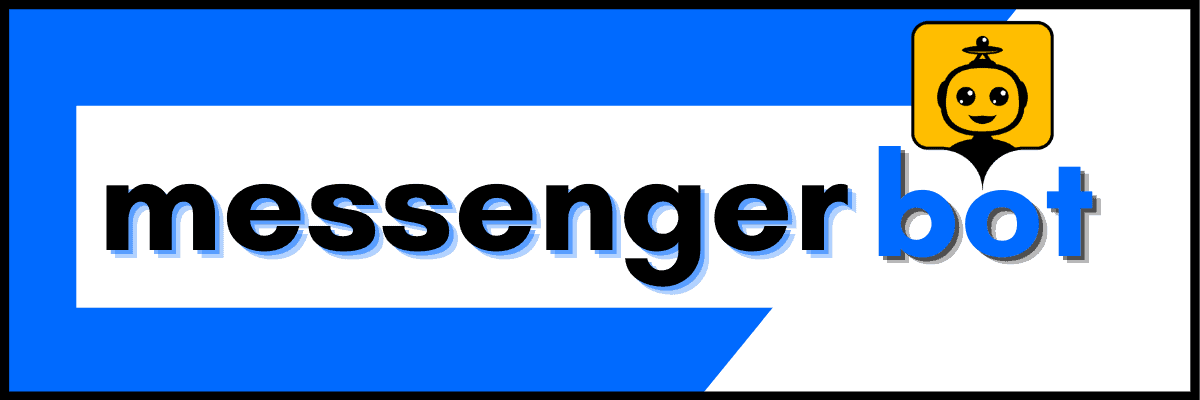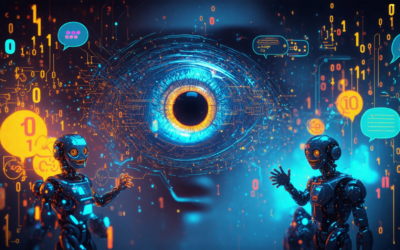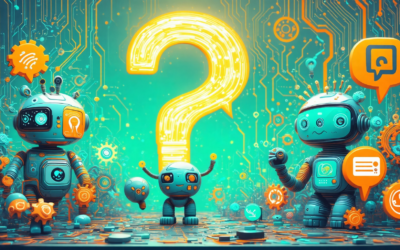In today’s digital landscape, the term automated bot has become increasingly prevalent, sparking curiosity and debate about their functionality and legality. This article aims to unravel the complexities surrounding automated bots, starting with a clear definition and an exploration of their key features. As we delve deeper, we will address critical questions such as, Are automated bots illegal? and Who controls bots?, providing insights into the legal implications and management of these technologies. Furthermore, we will examine the various industries that benefit from automated bots, showcasing real-world applications and examples. Additionally, we will clarify the distinction between bots and artificial intelligence, highlighting the evolution of these technologies. By the end of this article, you will have a comprehensive understanding of automated bots, their uses, and the regulatory frameworks that govern them, empowering you to navigate this fascinating field with confidence.
What is an automated bot?
An automated bot is a software application designed to perform tasks automatically, often over the internet, without human intervention. These bots are integral to enhancing digital communication and streamlining various processes across industries. Understanding the definition and functionalities of automated bots is essential for leveraging their capabilities effectively.
Understanding the Definition of Automated Bots
Automated bots operate independently, executing tasks without the need for a human to initiate them. They function over networks, particularly the internet, allowing them to interact with various online platforms and services. Here are key aspects of automated bots:
- Independence: Bots can operate autonomously, executing tasks without human oversight.
- Network Operation: They interact with online platforms, enhancing user engagement and operational efficiency.
- Task Automation: Bots excel at performing repetitive tasks, such as:
- Web Interaction: Engaging with websites to gather information or execute commands.
- Content Scanning: Analyzing and indexing content for search engines, exemplified by Googlebot, which aids in content discovery and ranking.
- User Interaction: Chatbots, like Messenger Bots, assist users by providing instant responses and support in customer service scenarios.
- Types of Bots:
- Search Engine Bots: Index web pages to improve search engine results.
- Customer Service Bots: Enhance user experience by answering queries and providing assistance.
- Virtual Assistants: Tools like Siri or Alexa that help users manage tasks and information.
- Pre-fill Bots: Streamline data entry by automatically populating fields in forms based on existing data.
- Benefits of Bots:
- Efficiency: Execute tasks more quickly and accurately than humans, significantly improving productivity.
- Cost Savings: Reduce the need for manual labor, leading to lower operational costs.
- Data Accuracy: Minimize human error, ensuring correct data processing and entry.
- Risks of Bots: While many bots are beneficial, some are malicious, designed to exploit vulnerabilities, such as:
- Account Breaches: Attempting to gain unauthorized access to user accounts.
- Data Scraping: Collecting sensitive information without consent.
In summary, automated bots are powerful tools that enhance efficiency and accuracy across various applications, from customer service to data management, while also posing certain risks that require careful management. For further reading on the implications and functionalities of bots, refer to sources such as the MIT Technology Review and the Pew Research Center.
Key Features of Automated Bots
Automated bots come equipped with several key features that make them indispensable in modern digital interactions:
- Automated Responses: Bots utilize AI-driven technology to provide real-time, automated responses to user inquiries across social media platforms like Facebook and Instagram, as well as on websites via direct integration.
- Workflow Automation: They enable businesses to create dynamic automated workflows triggered by specific user behaviors, facilitating tailored interactions that can improve user engagement and satisfaction.
- Lead Generation: By leveraging advanced messaging techniques, bots help businesses generate leads cost-effectively through interactive and engaging messenger-based marketing strategies.
- Multilingual Support: Bots can communicate in various languages, making it possible for businesses to reach a diverse global audience by delivering responses in the user’s preferred language.
- SMS Capabilities: They extend functionality to mobile devices, offering SMS broadcasting and sequence messaging, allowing businesses to connect with customers directly through their mobile phones.
These features not only enhance customer interactions but also streamline business operations, making automated bots a vital component of contemporary digital strategies. For more insights into how automated bots can revolutionize customer support, check out our article on the best AI chatbots.

Are Automated Bots Illegal?
Legal Implications of Using Automated Bots
The legality of automated bots varies significantly across jurisdictions and depends on their intended use. Here are key points to consider:
1. **Fraudulent Activities**: Many countries have enacted laws targeting bots that engage in fraudulent activities. In the United States, for example, the Better Online Ticket Sales (BOTS) Act prohibits the use of bots to bypass security measures on ticket-selling websites, aiming to protect consumers from unfair practices (U.S. Congress, 2016).
2. **Data Scraping**: Bots that scrape data from websites can also face legal challenges. The Computer Fraud and Abuse Act (CFAA) in the U.S. has been used to prosecute individuals and companies that unlawfully access and extract data from websites without permission (Van Alstyne, 2020).
3. **Messaging Bots**: While many bots, such as Messenger Bots, are used for legitimate purposes like customer service and engagement, they must comply with regulations such as the General Data Protection Regulation (GDPR) in Europe, which governs data privacy and user consent (European Commission, 2018).
4. **E-commerce and Bots**: In e-commerce, the use of bots for purchasing limited-edition items can lead to legal scrutiny. Some states have introduced legislation to curb the use of bots in this context, aiming to ensure fair access to products for all consumers (State of California, 2019).
5. **Ethical Considerations**: Beyond legality, ethical considerations play a crucial role in the deployment of bots. Companies must consider the impact of their bots on user experience and privacy, ensuring transparency and compliance with applicable laws.
In conclusion, while not all automated bots are illegal, their legality hinges on their function and adherence to specific laws and regulations. It is essential for businesses and developers to stay informed about the legal landscape surrounding bot usage to avoid potential legal repercussions.
Case Studies on Bot Legality
Examining real-world examples can shed light on the complexities surrounding the legality of automated bots.
1. **Ticketing Bots**: The enforcement of the BOTS Act has led to significant legal actions against companies using bots to purchase concert and sports tickets in bulk, which deprives genuine fans of fair access. This has prompted a broader discussion about the ethics of automated purchasing in competitive markets.
2. **Data Scraping Lawsuits**: A notable case involved LinkedIn, which took legal action against a data scraping bot that was accessing user profiles without permission. The court ruled in favor of LinkedIn, emphasizing the importance of user consent and the protection of data privacy (LinkedIn Corp. v. hiQ Labs, Inc., 2019).
3. **GDPR Compliance**: Companies utilizing Messenger Bots must ensure they comply with GDPR regulations. A case involving a European retailer highlighted the consequences of failing to obtain user consent before sending marketing messages through automated bots, resulting in hefty fines and reputational damage.
These case studies illustrate the importance of understanding the legal framework surrounding automated bots and the potential risks associated with non-compliance. For more insights on how automated bots can enhance customer engagement while adhering to legal standards, explore our [Messenger Bot features](https://messengerbot.app/#features).
**References**:
– U.S. Congress. (2016). Better Online Ticket Sales (BOTS) Act.
– Van Alstyne, M. (2020). The Computer Fraud and Abuse Act: A Legal Overview.
– European Commission. (2018). General Data Protection Regulation (GDPR).
– State of California. (2019). California Assembly Bill No. 847.
– LinkedIn Corp. v. hiQ Labs, Inc., 2019.
Why Would Someone Use a Bot?
Utilizing an automated bot can transform the way businesses operate and engage with their customers. The benefits of using automated bots span across various industries, enhancing efficiency and improving user interactions. Here are some key advantages:
Benefits of Using Automated Bots in Various Industries
- Automation of Repetitive Tasks: Bots excel at handling repetitive tasks such as data entry, scheduling, and customer support inquiries. This automation frees up human resources for more complex and creative work, enhancing overall productivity.
- 24/7 Availability: Unlike humans, bots can operate around the clock without breaks. This constant availability is particularly beneficial for businesses that require continuous customer engagement, such as through chatbots on platforms like Messenger, which can provide instant responses to customer queries.
- Data Processing and Analysis: Bots can quickly analyze large volumes of data, providing insights that would take humans significantly longer to compile. This capability is essential for businesses looking to make data-driven decisions.
- Cost Efficiency: By automating tasks, bots can significantly reduce operational costs. Businesses can save on labor costs while maintaining high levels of service quality.
- Enhanced User Experience: Bots can improve user experience by providing instant responses and personalized interactions. For example, Messenger bots can assist users in navigating services or products, leading to higher customer satisfaction.
- Scalability: Bots allow businesses to scale operations without a corresponding increase in human resources. As demand grows, bots can handle increased workloads seamlessly.
Automated Bot Examples in Everyday Applications
Automated bots are increasingly integrated into everyday applications, showcasing their versatility and effectiveness. Here are some common examples:
- Customer Support Bots: Many businesses deploy Messenger bots to handle customer inquiries, providing immediate assistance and reducing wait times.
- Lead Generation Bots: Bots can engage potential customers through interactive messaging, capturing leads efficiently and effectively.
- E-Commerce Bots: Automated bots assist in online shopping experiences by guiding users through product selections and facilitating transactions.
- Social Media Management Bots: These bots automate tasks such as post scheduling and comment moderation, enhancing brand engagement on platforms like Facebook and Instagram.
- Multilingual Support Bots: Bots equipped with multilingual capabilities can cater to diverse audiences, ensuring effective communication across different languages.
In summary, the implementation of automated bots can significantly enhance operational efficiency, improve customer interactions, and provide valuable insights across various industries. By leveraging these tools, businesses can stay competitive and responsive to their customers’ needs.
Are Automated Trading Bots Legal?
Automated trading bots, often referred to as algorithmic trading systems, are legal in many jurisdictions, including the United States and the European Union. However, their legality can vary significantly based on the specific regulations of each country and the nature of the trading strategies employed. Here are key points to consider regarding the legality of trading bots:
Regulatory Framework Surrounding Automated Trading Bots
- Regulatory Compliance: Trading bots must comply with the regulations set forth by financial authorities, such as the Securities and Exchange Commission (SEC) in the U.S. and the Financial Conduct Authority (FCA) in the UK. These regulations are designed to prevent market manipulation and ensure fair trading practices.
- Liability Issues: A significant legal question arises concerning liability. If an AI trading bot develops its own trading strategies or modifies existing ones, determining responsibility for any market violations can be complex. Legal experts are currently debating whether the developers, users, or the bots themselves could be held accountable for illegal activities.
- Market Manipulation Concerns: The use of trading bots can lead to concerns about market manipulation, particularly if they engage in practices like spoofing or wash trading. Regulatory bodies are increasingly scrutinizing automated trading to ensure compliance with laws designed to maintain market integrity.
- Transparency and Disclosure: Many jurisdictions require that users of trading bots disclose their use to the relevant authorities. This transparency helps regulators monitor trading activities and ensure that automated systems do not engage in unethical practices.
- Technological Advancements: As AI technology evolves, so too do the capabilities of trading bots. This raises ongoing legal questions about the extent to which these bots can operate independently and the implications of their actions in the financial markets.
For further reading on the legal landscape of automated trading, refer to resources from the SEC and the FCA, which provide comprehensive guidelines and updates on trading regulations.
Risks and Considerations in Automated Trading
While automated trading bots offer numerous advantages, they also come with inherent risks that users must consider:
- Market Volatility: Automated trading can amplify market volatility, especially during unexpected events. Bots may react quickly to market changes, which can lead to significant losses if not properly managed.
- Technical Failures: Dependence on technology means that any technical failure, such as server outages or software bugs, can disrupt trading activities and result in financial losses.
- Over-Optimization: Traders may fall into the trap of over-optimizing their bots based on historical data, which can lead to poor performance in real-time trading conditions.
- Regulatory Changes: As regulations evolve, users must stay informed about any changes that could affect the legality or functionality of their trading bots.
Understanding these risks is crucial for anyone considering the use of automated trading bots. By staying informed and compliant with regulations, traders can leverage these powerful tools while minimizing potential downsides.

Who Controls Bots?
Bots are automated software applications that perform tasks over the internet, and their control is typically managed through various mechanisms depending on their purpose and functionality. Understanding who controls bots is essential for grasping their impact on digital interactions and security.
Overview of Bot Management and Control
Control over bots involves several key players and systems:
- Bot Managers: Organizations often employ bot management solutions as part of their web application security strategy. These tools help in identifying, classifying, and managing bot traffic. They can distinguish between beneficial bots (like search engine crawlers) and malicious bots (such as those used for scraping or launching DDoS attacks). By implementing rules, bot managers can allow or block specific bots based on their behavior and reputation. Source: Kaspersky
- Developers and Companies: The creators of bots, including developers and companies, have control over their design and functionality. They set parameters that dictate how bots operate, including their interaction with users and systems. For example, Messenger Bots, developed for platforms like Facebook, are programmed to engage with users, providing information or services based on user queries.
- Regulatory Bodies: In some cases, regulatory frameworks govern the use of bots, especially in sectors like finance and healthcare. These regulations ensure that bots operate within legal boundaries, protecting user data and privacy.
- End Users: Users can also exert control over bots by choosing which services to engage with and how much information to share. For instance, users can block or report bots that they find intrusive or harmful.
- Artificial Intelligence: Many modern bots utilize AI and machine learning algorithms, which allow them to adapt and learn from interactions. This self-learning capability means that while developers set the initial parameters, the bots can evolve in their operations based on user behavior and feedback.
The Role of Developers in Bot Functionality
Developers play a crucial role in shaping the functionality of automated bots. They are responsible for:
- Designing User Interactions: Developers create the conversational flows and responses that bots use to interact with users, ensuring that the engagement is both effective and user-friendly.
- Implementing Security Measures: Security is paramount, especially for bots handling sensitive information. Developers integrate security protocols to protect user data and prevent unauthorized access.
- Continuous Improvement: By analyzing user interactions and feedback, developers can refine bot algorithms, enhancing their performance and responsiveness over time.
- Integration with Other Systems: Developers ensure that bots can seamlessly integrate with other software and platforms, such as CRM systems or e-commerce solutions, to provide a comprehensive user experience.
In conclusion, the control of bots is a multifaceted issue involving bot management tools, developers, regulatory frameworks, end users, and AI technologies, all working together to ensure that bots serve their intended purposes without compromising security or user experience.
What is a bot vs AI?
The distinction between a bot and AI is crucial in understanding their functionalities and applications in technology. While both serve to enhance user interaction and automate processes, they operate on different principles and capabilities.
Distinguishing Between Bots and Artificial Intelligence
Definition:
- Bot: A bot, short for “robot,” is a software application designed to automate tasks. Bots can perform simple, repetitive tasks such as responding to user queries or executing commands based on predefined rules. They often operate on scripted workflows and are limited in their ability to adapt to new situations.
- AI (Artificial Intelligence): AI refers to the simulation of human intelligence in machines that are programmed to think and learn. AI encompasses a broader range of technologies, including machine learning, natural language processing (NLP), and neural networks, enabling systems to analyze data, learn from experiences, and make decisions.
Functionality:
- Chatbots: These are a type of bot specifically designed for conversation. They follow scripted dialogues and can handle basic customer service inquiries. For example, a Messenger Bot can assist users by providing information or answering FAQs based on a set script.
- AI Agents: Unlike traditional chatbots, AI agents leverage generative AI and large language models (LLMs) to understand context and nuance in conversations. They can learn from interactions, adapt responses, and handle complex queries, making them more versatile and effective in customer engagement.
The Evolution of Bots in the Context of AI Technologies
As technology advances, the capabilities of bots have evolved significantly. Traditional bots were limited to executing predefined tasks without the ability to learn or adapt. In contrast, modern AI-driven bots, such as Messenger Bot, utilize sophisticated algorithms to enhance user interactions.
- Technological Basis: Traditional chatbots typically rely on rule-based systems that require manual input to create conversation flows. They lack the ability to learn from past interactions. In contrast, AI agents utilize advanced technologies such as deep learning and NLP, allowing them to process and generate human-like responses. This capability enables them to engage in more meaningful and dynamic conversations.
- Use Cases: Chatbots are commonly used for customer support, appointment scheduling, and basic information retrieval. AI agents, however, are employed in more complex scenarios, such as personalized recommendations, predictive analytics, and interactive virtual assistants.
In summary, while both bots and AI serve to enhance user interaction and automate processes, AI agents represent a significant advancement in technology, offering greater adaptability and intelligence compared to traditional bots. For further insights into how AI is transforming customer engagement, explore the best AI chatbots and their applications.
Exploring Automation Bot Software
Best Automated Bot Solutions Available Today
When it comes to selecting the best automated bot solutions, several platforms stand out for their robust features and user-friendly interfaces. One of the leading options is Messenger Bot, which excels in providing automated responses across various channels, including social media and websites. Its AI-driven technology ensures real-time engagement, making it a top choice for businesses looking to enhance customer interactions.
Another noteworthy competitor is Brain Pod AI, which offers a range of AI services, including a multilingual AI chat assistant that can cater to diverse audiences. This flexibility is crucial for businesses aiming to expand their reach globally. Additionally, Brain Pod AI provides comprehensive pricing options, making it accessible for businesses of all sizes.
Other notable automated bot solutions include:
- Zendesk Chat: Known for its seamless integration with customer support systems, Zendesk Chat offers automated responses that enhance user experience.
- Drift: Focused on lead generation, Drift uses chatbots to engage visitors in real-time, significantly improving conversion rates.
- Intercom: This platform combines automated messaging with personalized customer support, making it a favorite among tech-savvy businesses.
Understanding Bot Automation Meaning and Its Applications
Bot automation refers to the use of software applications to perform tasks that would typically require human intervention. This technology is transforming various industries by streamlining processes and enhancing efficiency. For instance, in customer service, automated bots can handle inquiries, provide information, and resolve issues without human oversight, thereby reducing response times and improving customer satisfaction.
In e-commerce, automated bots facilitate lead generation and cart recovery, allowing businesses to engage customers effectively. The integration of bots into marketing strategies enables personalized interactions, which can significantly boost conversion rates. Moreover, with features like multilingual support, platforms like Messenger Bot can cater to a global audience, breaking down language barriers and enhancing user experience.
Overall, the applications of automated bots are vast, ranging from customer support to marketing automation, making them an invaluable tool for businesses aiming to optimize their operations and improve customer engagement.




